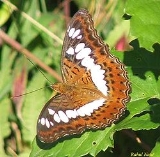
Limenitis procris
Encyclopedia
The Commander sometimes included in the genus
Limenitis
), is a medium-sized, strikingly coloured brush-footed butterfly found in Asia
. It is notable for the mode of concealment employed by its caterpillar and the cryptic camouflage
of its pupa.
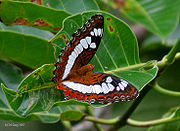 The Commander has a wingspan of about 6 to 7.5 cm. The upperside of its wings are a bright reddish brown. Towards the centre of the wing are broad white spots. In flight, one can see a bright red brown butterfly with a white band forming a 'V shape'. There are also a few white spots scattered on the wings. Its hindwings have crenulated margins. The undersides of the wings are a whitish gray toward the base and have a row of dull reddish brown and a row of black spots along the margins.
The Commander has a wingspan of about 6 to 7.5 cm. The upperside of its wings are a bright reddish brown. Towards the centre of the wing are broad white spots. In flight, one can see a bright red brown butterfly with a white band forming a 'V shape'. There are also a few white spots scattered on the wings. Its hindwings have crenulated margins. The undersides of the wings are a whitish gray toward the base and have a row of dull reddish brown and a row of black spots along the margins.
The male and female are similar in appearance.
, Peninsular India, the Himalayas
east of the Dun valley, through Kumaon
, Nepal
, Sikkim
to Assam, Arunachal and onto Myanmar
. Locally abundant, it is common from Sri Lanka to Maharashtra. It is rare in Gujarat and far more common in the Himalayas.
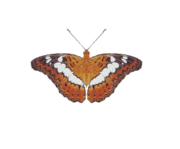
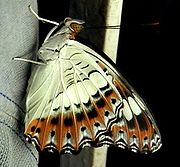 The Commander is generally found in forested regions having moderate to heavy rainfall. It usually keeps to low elevations, that is, up to 3000 feet into the hills.
The Commander is generally found in forested regions having moderate to heavy rainfall. It usually keeps to low elevations, that is, up to 3000 feet into the hills.
It is fond of open glades, roadsides and clearings in forests. It is abundant along water courses in dry and moist deciduous
forests. It is also found close to villages or wherever it's larval host-plant Mussaenda frondosa is to be found. It is most common in the post-monsoon months and winter.
The Commander can often be spotted basking with its wings pressed flat on exposed stones in streambeds. Individuals settle down on an exposed perch high up in the trees during the heat of the day. At this time it can be seen defending its territory and driving intruding butterflies away.
This butterfly has a swift flight with rapid wingbeats and alternate spurts of smooth gliding. A powerful flier, it nevertheless flies for short distances at a time. Being wary, it maintains its distance and is best caught when engrossed in mud-puddling
or feeding from flowers. It regularly visits flowers from low-lying herbs to high up in the trees. Though this is a mud-puddling species, in Borneo
and probably elsewhere, adults do not visit carrion
or old fruit
to drink liquids.
.
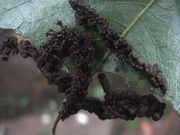
is dirty brown with a chestnut tinge and dark brown splotches all over. The body also bears numerous processes which help to break up its outline. The behaviour of this caterpillar is very interesting in that it is one of the species of butterfly that makes long chains of frass
. It eats up part of the leaf it is on and uses bits of leaves which are strung up with silk along with droppings.
The caterpillar rests on the exposed mid rib of a leaf after removing the leafy portions on the sides. This behaviour may be to dissuade ants from crossing over the chain of frass
behind which the caterpillar rests.
ting, the caterpillar wanders around, often far away from the plant it fed on. It pupates among dried leaves and twigs. The pupa is brownish in color and rough in texture. It is angular with prominent wing expansions and bears flat processes on the head which curl together making a hole between them. It also has numerous lines and markings that make it look like a rolled up dried leaf.
Genus
In biology, a genus is a low-level taxonomic rank used in the biological classification of living and fossil organisms, which is an example of definition by genus and differentia...
Limenitis
Limenitis
Limenitis is a genus of brush-footed butterflies, commonly called the Admirals. The Sister butterflies and Commander butterflies are sometimes included here....
), is a medium-sized, strikingly coloured brush-footed butterfly found in Asia
Asia
Asia is the world's largest and most populous continent, located primarily in the eastern and northern hemispheres. It covers 8.7% of the Earth's total surface area and with approximately 3.879 billion people, it hosts 60% of the world's current human population...
. It is notable for the mode of concealment employed by its caterpillar and the cryptic camouflage
Camouflage
Camouflage is a method of concealment that allows an otherwise visible animal, military vehicle, or other object to remain unnoticed, by blending with its environment. Examples include a leopard's spotted coat, the battledress of a modern soldier and a leaf-mimic butterfly...
of its pupa.
Description

The male and female are similar in appearance.
Range
Sri LankaSri Lanka
Sri Lanka, officially the Democratic Socialist Republic of Sri Lanka is a country off the southern coast of the Indian subcontinent. Known until 1972 as Ceylon , Sri Lanka is an island surrounded by the Indian Ocean, the Gulf of Mannar and the Palk Strait, and lies in the vicinity of India and the...
, Peninsular India, the Himalayas
Himalayas
The Himalaya Range or Himalaya Mountains Sanskrit: Devanagari: हिमालय, literally "abode of snow"), usually called the Himalayas or Himalaya for short, is a mountain range in Asia, separating the Indian subcontinent from the Tibetan Plateau...
east of the Dun valley, through Kumaon
Kumaon Division
For Kumaoni/Kumauni People see Kumauni PeopleKumaon or Kumaun is one of the two regions and administrative divisions of Uttarakhand, a mountainous state of northern India, the other being Garhwal. It includes the districts of Almora, Bageshwar, Champawat, Nainital, Pithoragarh, and Udham Singh Nagar...
, Nepal
Nepal
Nepal , officially the Federal Democratic Republic of Nepal, is a landlocked sovereign state located in South Asia. It is located in the Himalayas and bordered to the north by the People's Republic of China, and to the south, east, and west by the Republic of India...
, Sikkim
Sikkim
Sikkim is a landlocked Indian state nestled in the Himalayan mountains...
to Assam, Arunachal and onto Myanmar
Myanmar
Burma , officially the Republic of the Union of Myanmar , is a country in Southeast Asia. Burma is bordered by China on the northeast, Laos on the east, Thailand on the southeast, Bangladesh on the west, India on the northwest, the Bay of Bengal to the southwest, and the Andaman Sea on the south....
. Locally abundant, it is common from Sri Lanka to Maharashtra. It is rare in Gujarat and far more common in the Himalayas.
Ecology


It is fond of open glades, roadsides and clearings in forests. It is abundant along water courses in dry and moist deciduous
Deciduous
Deciduous means "falling off at maturity" or "tending to fall off", and is typically used in reference to trees or shrubs that lose their leaves seasonally, and to the shedding of other plant structures such as petals after flowering or fruit when ripe...
forests. It is also found close to villages or wherever it's larval host-plant Mussaenda frondosa is to be found. It is most common in the post-monsoon months and winter.
The Commander can often be spotted basking with its wings pressed flat on exposed stones in streambeds. Individuals settle down on an exposed perch high up in the trees during the heat of the day. At this time it can be seen defending its territory and driving intruding butterflies away.
This butterfly has a swift flight with rapid wingbeats and alternate spurts of smooth gliding. A powerful flier, it nevertheless flies for short distances at a time. Being wary, it maintains its distance and is best caught when engrossed in mud-puddling
Mud-puddling
Mud-puddling is the phenomenon mostly seen in butterflies and involves their aggregation on substrates like wet soil, dung and carrion to obtain nutrients such as salts and amino acids. This behaviour has also been seen in some other insects, notably the leafhoppers.Lepidoptera are diverse in...
or feeding from flowers. It regularly visits flowers from low-lying herbs to high up in the trees. Though this is a mud-puddling species, in Borneo
Borneo
Borneo is the third largest island in the world and is located north of Java Island, Indonesia, at the geographic centre of Maritime Southeast Asia....
and probably elsewhere, adults do not visit carrion
Carrion
Carrion refers to the carcass of a dead animal. Carrion is an important food source for large carnivores and omnivores in most ecosystems. Examples of carrion-eaters include vultures, hawks, eagles, hyenas, Virginia Opossum, Tasmanian Devils, coyotes, Komodo dragons, and burying beetles...
or old fruit
Fruit
In broad terms, a fruit is a structure of a plant that contains its seeds.The term has different meanings dependent on context. In non-technical usage, such as food preparation, fruit normally means the fleshy seed-associated structures of certain plants that are sweet and edible in the raw state,...
to drink liquids.
Host plants
Most of the larval host plants belong to the family RubiaceaeRubiaceae
The Rubiaceae is a family of flowering plants, variously called the coffee family, madder family, or bedstraw family. The group contains many commonly known plants, including the economically important coffee , quinine , and gambier , and the horticulturally valuable madder , west indian jasmine ,...
.
- Neolamarckia cadambaNeolamarckia cadambaNeolamarckia cadamba, commonly called Kadam is an evergreen, tropical tree native to South and Southeast Asia. The genus name "Lamarckia" is derived from the name of French naturalist Jean-Baptiste Lamarck.-Description:...
(Kadam) - Mussaenda frondosa
- Wendlandia thyrsoidea
- Wendlandia exserta
- CinchonaCinchonaCinchona or Quina is a genus of about 38 species in the family Rubiaceae, native to tropical South America. They are large shrubs or small trees growing 5–15 metres in height with evergreen foliage. The leaves are opposite, rounded to lanceolate and 10–40 cm long. The flowers are white, pink...
spp. (Quinine trees) - Cadaba fruitcosa
- Mitragyna parviflora
- Hedyotis orixense
- Ochreinauclea missionisOchreinauclea missionisOchreinauclea missionis is a species of plant in the Rubiaceae family. It is endemic to India. It is threatened by habitat loss.The caterpillars of the Commander , a brush-footed butterfly, utilize this species as a foodplant....
Egg
The female Commander lays a single egg on the underside of the tip of a leaf of the food plant. The egg is hairy and greenish and looks like a green strawberry. The egg hatches in 3 to 4 days.
Caterpillar
The caterpillarCaterpillar
Caterpillars are the larval form of members of the order Lepidoptera . They are mostly herbivorous in food habit, although some species are insectivorous. Caterpillars are voracious feeders and many of them are considered to be pests in agriculture...
is dirty brown with a chestnut tinge and dark brown splotches all over. The body also bears numerous processes which help to break up its outline. The behaviour of this caterpillar is very interesting in that it is one of the species of butterfly that makes long chains of frass
Frass
Frass is the fine powdery material phytophagous insects pass as waste after digesting plant parts. It causes plants to excrete chitinase due to high chitin levels, it is a natural bloom stimulant, and has high nutrient levels. Frass is known to have abundant amoeba, beneficial bacteria, and fungi...
. It eats up part of the leaf it is on and uses bits of leaves which are strung up with silk along with droppings.
The caterpillar rests on the exposed mid rib of a leaf after removing the leafy portions on the sides. This behaviour may be to dissuade ants from crossing over the chain of frass
Frass
Frass is the fine powdery material phytophagous insects pass as waste after digesting plant parts. It causes plants to excrete chitinase due to high chitin levels, it is a natural bloom stimulant, and has high nutrient levels. Frass is known to have abundant amoeba, beneficial bacteria, and fungi...
behind which the caterpillar rests.
Pupa
Before pupaPupa
A pupa is the life stage of some insects undergoing transformation. The pupal stage is found only in holometabolous insects, those that undergo a complete metamorphosis, going through four life stages; embryo, larva, pupa and imago...
ting, the caterpillar wanders around, often far away from the plant it fed on. It pupates among dried leaves and twigs. The pupa is brownish in color and rough in texture. It is angular with prominent wing expansions and bears flat processes on the head which curl together making a hole between them. It also has numerous lines and markings that make it look like a rolled up dried leaf.

